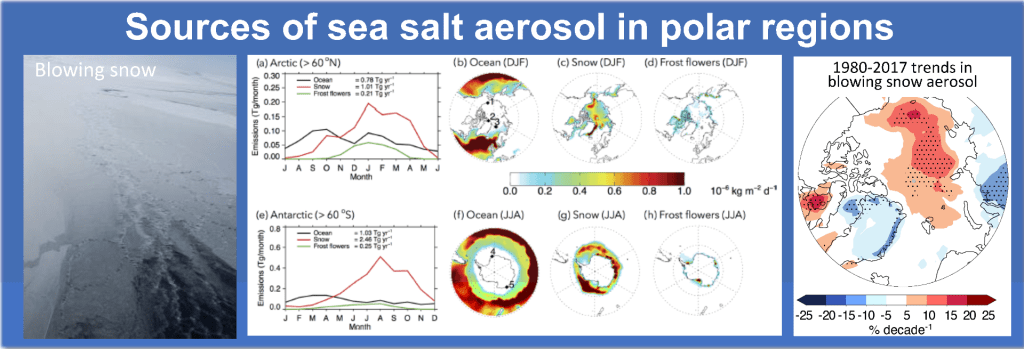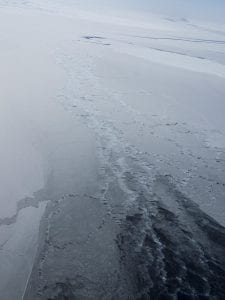
Breaking waves over the open ocean are recognized as the main mechanism generating sea salt particles in the atmosphere. Yet, observations of sea salt particles over polar regions display characteristics that are inconsistent with this source from the open ocean. In this project we examine a new source of sea salt particles over sea ice surfaces: sublimation of saline blowing snow particles.

Some of our findings:
Huang & Jaeglé (2018). Wintertime enhancements of sea salt aerosol in polar regions consistent with a sea ice source from blowing snow. Atmospheric Chemistry and Physics. Link. We implement a blowing snow and frost flower parameterizations in the GEOS-Chem chemical transport model, which we validate against multi-year in situ observations of sea salt aerosol at coastal sites in the  Arctic and Antarctic. We find that the simulation with blowing snow emissions of sea salt aerosol is able to reproduce the wintertime observed levels of sea salt aerosol as well as their large day-to-day variability. The frost flower simulation cannot fully explain the seasonal cycle and daily variability of the observations. Overall, this comparison suggests that blowing snow is likely to be the dominant source of sea salt aerosol during winter, with frost flower playing a much smaller role.
Arctic and Antarctic. We find that the simulation with blowing snow emissions of sea salt aerosol is able to reproduce the wintertime observed levels of sea salt aerosol as well as their large day-to-day variability. The frost flower simulation cannot fully explain the seasonal cycle and daily variability of the observations. Overall, this comparison suggests that blowing snow is likely to be the dominant source of sea salt aerosol during winter, with frost flower playing a much smaller role.
Huang, Jaeglé & Shah (2018). Using CALIOP to constrain blowing snow emissions of sea salt aerosols over Arctic and Antarctic sea ice. Atmospheric Chemistry and Physics. Link. In this study, we use 2007–2009 aerosol extinction coefficients from the CALIOP lidar onboard the CALIPSO satellite and the GEOS-Chem global chemical transport model to constrain sources of sea salt aerosol over Arctic and Antarctic sea ice. We find that a standard GEOS-Chem simulation without sea ice sources of sea salt aerosol  underestimates CALIOP extinctions by 50-70% over Arctic and Antarctic sea ice. We find that the addition of blowing snow emissions of sea salt aerosol is necessary for the GEOS-Chem model to reproduce the CALIOP aerosol extinctions over sea ice regions during cold months. Using the CALIOP aerosol extinction coefficients, we derived monthly-varying surface snow salinities, which further improves the performance of the blowing snow GEOS-Chem simulation.
underestimates CALIOP extinctions by 50-70% over Arctic and Antarctic sea ice. We find that the addition of blowing snow emissions of sea salt aerosol is necessary for the GEOS-Chem model to reproduce the CALIOP aerosol extinctions over sea ice regions during cold months. Using the CALIOP aerosol extinction coefficients, we derived monthly-varying surface snow salinities, which further improves the performance of the blowing snow GEOS-Chem simulation.
Confer, K. L., et al. (2023). Impact of changing Arctic sea ice extent, sea ice age, and snow depth on sea salt aerosol from blowing snow and the open ocean for 1980-2017. Journal of Geophysical Research-Atmospheres. Here we use model simulations to examine how changing Arctic conditions have impacted sea salt particles in the atmosphere. Our simulations show that the concentrations of sea salt particles have increased by more than 6% per decade over the 1980–2017 period. During cold months, this increase is due to saltier blowing snow particles as older sea ice with less salty snow is being replaced by younger sea ice with more salty snow. During warmer months, this increase is the result of larger open ocean emissions as sea ice is melting. These changes in sea salt particles could potentially affect Arctic bromine activation and climate.

People: Jiayue Huang, Caitlyn Confer, Joe Robinson, Lyatt Jaeglé|
Funding: NASA, Atmospheric Chemistry Modeling and Analysis Program (ACMAP). NASA, CALIPSO/CloudSat Science Team Recompete.
Publications:
- Jaeglé, L. (2023). Blowing hot and cold. Nat. Geosci. https://doi.org/10.1038/s41561-023-01261-9. Link.
- Confer, K. L., Jaeglé, L., Liston, G. E., Sharma, S., Nandan, V., Yackel, J., Ewert, M., Horowitz, H. M., 2023. Impact of changing Arctic sea ice extent, sea ice age, and snow depth on sea salt aerosol from blowing snow and the open ocean for 1980-2017, J. Geophys. Res.-Atmospheres. 128, e2022JD037667. https://doi.org/10.1029/2022JD037667
- Swanson, W.F., Holmes, C.D., Simpson, W.R., Confer, K., Marelle, L., Thomas, J.L., Jaeglé, L., Alexander, B., Zhai, S., Chen, Q., Wang, Z., and Sherwen, T., 2022, Comparison of model and ground observations finds snowpack and blowing snow both contribute to Arctic troposphere reactive bromine, Atmos. Chem. Phys., 22, 14467–14488, https://doi.org/10.5194/acp-22-14467-2022.
- , , , , , , Huang, J., Alexander, B., Jaeglé, L., Kennedy, J. A., Larrick, C., Kahle, E. C., Steig, E. J., Jones, T. R., 2021. Seasonally resolved Holocene sea ice variability inferred from South Pole ice core chemistry. Geophysical Research Letters, 48, e2020GL091602. https://doi-org/10.1029/2020GL091602
- Huang, J., Jaeglé, L., Chen, Q., Alexander, B., Sherwen, T., Evans, M. J., Theys, N., and Choi, S., 2020. Evaluating the impact of blowing snow sea salt aerosol on springtime BrO and O3 in the Arctic, Atmos. Chem. Phys., 20, 7335–7358, https://doi.org/10.5194/acp-20-7335-2020.
- Huang, J., Jaeglé, L., Shah, V., 2018. Using CALIOP to constrain blowing snow emissions of sea salt aerosols over Arctic and Antarctic sea ice. Atmos. Chem. Phys., 18, 16253-16269. https://doi.org/10.5194/acp-18-16253-2018
- Huang, J., Jaeglé, L., 2017. Wintertime enhancements of sea salt aerosol in polar regions consistent with a sea ice source from blowing snow. Atmos. Chem. Phys. 17, 3699–3712. https://doi.org/10.5194/acp-17-3699-2017